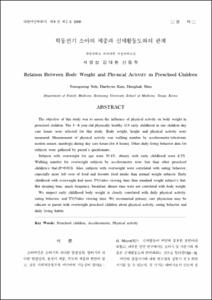KUMEL Repository
1. Journal Papers (연구논문)
1. School of Medicine (의과대학)
Dept. of Family Medicine (가정의학)
학동전기 소아의 체중과 신체활동도와의 관계
- Keimyung Author(s)
- Suh, Young Sung; Kim, Dae Hyun; Shin, Dong Hak
- Department
- Dept. of Family Medicine (가정의학)
- Journal Title
- 대한비만학회지
- Issued Date
- 2000
- Volume
- 9
- Issue
- 2
- Abstract
- The objective of this study was to assess the influence of physical activity on body weight in preschool children. The 3∼6 year-old physically healthy 113 early childhood in one children day care house were selected for this study. Body weight, height and physical activity were measured. Measurement of physical activity was walking number by accelerometer (electronic motion sensor, manbogi) during day care house (for 6 hours). Other daily living behavior data for subjects were gathered by parent's questionaire.
Subjects with overweight for age were 35.4%, obesity with early childhood were 6.2%. Walking number for overweight subjects by accelerometer were less than other preschool children's that (P=0.013). Also, subjects with overweight were correlated with eating behavior, especially more left over of food and favorite food intake than normal weight subjects. Early childhood with overweight had more TV/video viewing time than standard weight subject's that.
But sleeping time, snack frequency, breakfast, dinner time were not correlated with body weight.
We suspect early childhood body weight is closely correlated with daily physical activity, eating behavior, and TV/Video viewing time. We recommend primary care physicians may be educate to parent with overweight preschool children about physical activity, eating behavior and daily living habits.
유아에서 신체활동도 및 생활 습관이 유아의 체중에 미치는 영향에 대하여 알아보고자 1997년 9월 대구시내 소재하는 모 어린이집 원생 113명 (만 3∼6세 유아)을 대상으로 걸음 수를 기록하는 만보계를 이용하여 신체활동도를 측정하였고, 비만도의 판정은 키에 따른 표준체중에 현재체중과 비교하는 방법으로 비만도를 추정하였고, 유아의 부모에게 설문지를 보내어 조부모 동거, 형제유무, 부모운동유무 등의 가정환경을 조사하였고, 생활습관은 총 수면시간, TV 및 비디오 시청시간, 과외활동유무로 조사하였으며, 식사습관은 아침식사유무, 간식유무, 음식남김여부, 식욕유무 등을 조사하여 다음과 같은 결과를 얻었다. 1. 남아는 58명 (51.3%) 여아는 55명 (48.7%)이었고 평균나이는 남아 4.4±0.72세 여아는 4.6±0.99세였다. 표준체중표에 의한 비만도 평균은 남아 6.4±8.60%였고 여아는 7.5±11.73%였다. 표준체중의 20%이상을 비만으로 판정했을 때 비만한 유아는 6.2% (7명)였다. 2. 만보계로 측정된 신체활동도는 남아 2088.9±794.81보, 여아 2012.0±701.37보 였다. 나이, 비만도, 신체활동도에서 남녀 소아간의 유의한 차이가 없었다. 3. 식사습관과 비만도의 비교에서 식사시 음식을 남기지 않는 유아가 남기는 유아에 비해 유의하게 비만도가 높았으나 (p=0.008), 아침식사유무, 간식유무와 비만도의 비교에서는 유의한 차이가 없었다. 4. 비만도와 생활습관 및 식사습관간의 상관분석에서 비만도가 클수록 신체활동도는 유의하게 적었고(p<0.01), 음식을 남기지 않았으며 (p<0.05), 편식하지 않았으며 (p<0.05), TV/Video 시청시간이 많았다(p<0.05). 비만도와 총수면시간, 과외활동유무, 간식유무 및 아침 식사유무, 저녁식사시간과는 무관하였다. 유아의 체중은 신체활동도와 밀접한 관련이 있었고 식습관과도 관련이 많으므로, 유아의 체중과 생활 습관이 소아 및 성인으로 이어진다고 가정할 때 일차진료의사들은 유아를 둔 부모들에게 유아의 신체활동을 증가시킴과 동시에 건전한 식습관을 가지도록 교육하여야 한다고 사료되어진다.
- Alternative Title
- Relation Between Body Weight and Physical Activity in Preschool Children
- Publisher
- School of Medicine
- Citation
- 서영성 et al. (2000). 학동전기 소아의 체중과 신체활동도와의 관계. 대한비만학회지, 9(2), 146–152.
- Type
- Article
- ISSN
- 1226-4407
- Appears in Collections:
- 1. School of Medicine (의과대학) > Dept. of Family Medicine (가정의학)
- 파일 목록
-
-
Download
 oak-bbb-1464.pdf
기타 데이터 / 284.99 kB / Adobe PDF
oak-bbb-1464.pdf
기타 데이터 / 284.99 kB / Adobe PDF
-
Items in Repository are protected by copyright, with all rights reserved, unless otherwise indicated.